CoorTek developed the technology that makes ceramics transparent. Transparent ceramics have a higher thermal resistance than glass or resin and they are stronger and harder. They can be shaped more freely and their productivity is more efficient than single crystal. At present, we manufacture the transparent ceramics YAG (Y3Al5O12/yttrium aluminum garnet) and Y2O3 (yttrium oxide). Furthermore, through the use of doping, we can add optical functions to transparent ceramics such as wavelength conversion.
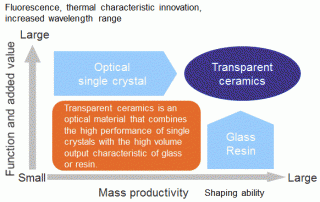
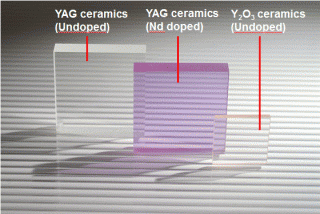
- Optical transparency
-
Polycrystalline ceramics generally consist of opaque matter that absorbs or scatters visible light. However, through highly controlled processes, ceramics can achieve a transparency similar to glass or single crystal sapphire. The transmittance rate for transparent ceramics in the visible light to middle infrared spectrum has been measured at approximately 84% for YAG and 81% for Y2O3. These ratios are equivalent to the transparency rates as calculated according to the materials refractive index.
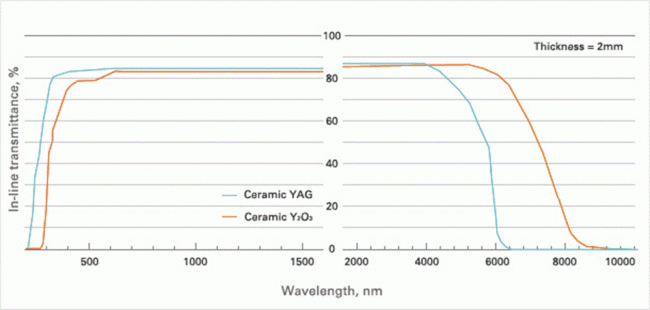
Transmittance of Transparent Ceramics
- Thermal resistance, strength and hardness
-
High temperature sintered transparent ceramics have a higher resistance and are stronger and harder than optical glass or resin. They maintain their transparency at temperatures of up to 1200°C, and they can be used stably in oxidized environments.
- Resistance to chemicals and corrosion
-
Highly pure, highly dense transparent ceramics hold up extremely well against oxygen and alkalis, and they resist highly corrosive halogen plasma. They can be used in harsh environments that glass and resins cannot tolerate.
- Optical functions
-
Through doping, it is possible to add optical functions such as wavelength conversion to transparent ceramics. For example, laser oscillation has been successfully achieved by doping YAG and Y2O3 transparent ceramics with neodymium (Nd) or ytterbium (Yb), the results of which reveal the same characteristics as single crystal.
- Mass productivity
-
Producing a single crystal optical part generally requires a considerable amount of time and effort since it must be cut from an ingot. This involves a fair amount of material loss during the machining process. On the other hand, with ceramics, it is possible to create and sinter a part from material that has been manufactured close to the shape of the final product, making this method suitable for low volume sample manufacturing and multi-variety manufacturing as well as high volume mass production.
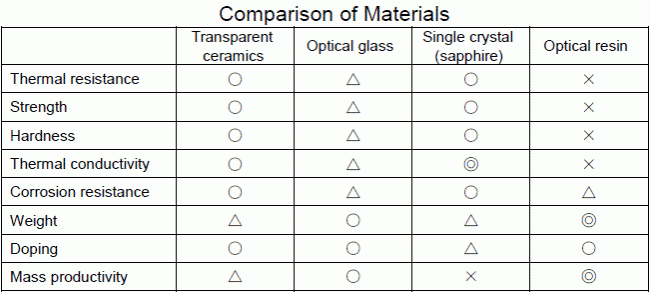
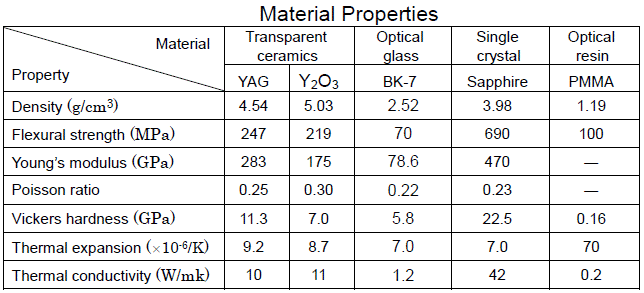
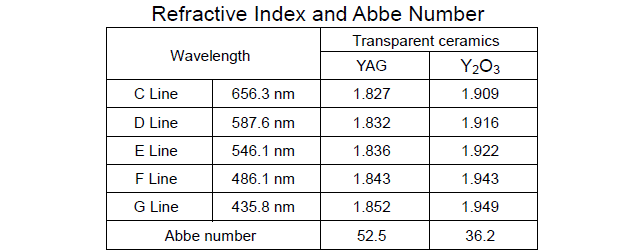
Ceramics are produced by sintering powdered materials that generally have light scattering characteristics. This is attributable to the ceramic powder having spaces between each grain of powder, the inconsistencies among the grains and the impurities that are present at the boundaries of the grains. Using a highly controlled process, we have been able to remove the light scattering attributes to develop a transparent ceramic, YAG (Y3Al5O12; yttrium aluminum garnet) and Y2O3 (yttrium oxide). These transparent ceramics have a polycrystalline structure with a transmittance rate that has been measured in the visible light to middle infrared spectrum at approximately 84% for YAG and 81% for Y2O3, which is equivalent to the transparency ratios calculated according to the materials refractive index.
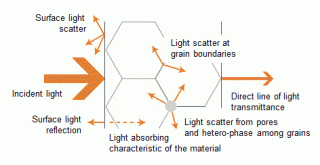
Causes of light scatter in ceramics
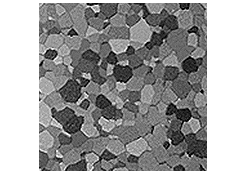
Microstructure of Transparent ceramics
Lenses, windows, laser hosts,scintillators,etc.
- “Making and Properties of Transparent YAG Ceramics”
- Fujita, M.
- Advanced Solid-State Photonics 2008, Ceramic Lasers Summit, Nara.
- “Precision Evaluation of Optical Properties of Transparent Ceramics”
- Yanase, Y., Fujita, M. and Irie, M.
- The 24th Japan-Korea International Seminar on Ceramics, Kakegawa, 2007.
- “Development of Transparent Polycrystalline Ceramics and Evaluation of Ceramic Laser”
- Imai, I., Fujita, M., Oishi, H., Irie, M., Kimijima, S. and Miyai, T.
- Optics & Photonics Japan 2006, Ceramic Laser International Workshop, Tokyo.
Glossary
- Polycrystal
- Polycrystal consists of large numbers of microcrystal grains. Interfaces known as grain boundaries exist between each grain. Nearly all metal and ceramic materials are polycrystal.
- Doping
- Doping is a process in which a small amount of additive is introduced into a material with the intent of changing its property so it can perform a new function. The additive is known as a dopant.
- Refractive index
- This index shows the extent to which a material inherently refracts light. The refraction is measured in a given value. Optical lenses can be designed more thinly by using a material with a higher refractive index.
- Abbe number
- This number represents the degree of dispersion (differences of refractive index by the wavelength). The larger the material's abbe number, the lower its degree of dispersion and the fewer the changes in its wavelength on the refractive index.








